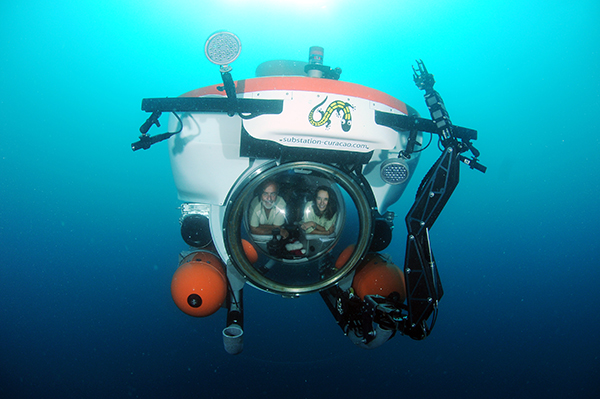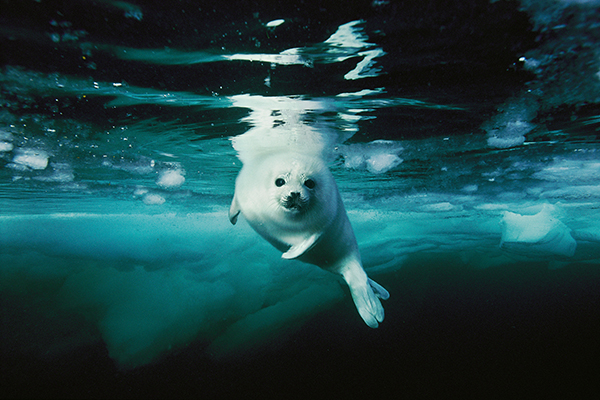Smithsonian features underwater art

The Smithsonian is celebrating the fifth anniversary of the opening of the Sant Ocean Hall with a gallery and two temporary exhibitions that celebrate the connection between humans and the oceans. The exhibitions feature the work of Brian Skerry, Cornelia Kubler Kavanagh and Gareth Lawson.
Press release
Smithsonian Celebrates Fifth Anniversary of Sant Ocean Hall
Three Exhibitions Open to Highlight Link between Humans and Ocean
In celebration of the Sant Ocean Hall’s fifth anniversary, the National Museum of Natural History will open three exhibitions Sept. 17 featuring the interconnected relationship between people and the ocean. The 23,000-square-foot Sant Ocean Hall opened in September 2008 with the mission to share the history of the ocean and its importance to contemporary society with the public. The hall is named for Roger and Vicki Sant, Washington philanthropists and Smithsonian supporters who donated $15 million in 2008 to support the renovation and opening of the hall. The National Oceanic and Atmospheric Administration partnered with the museum in 2008 to develop the Ocean Hall and contributed to the recent renovations to the “Living on an Ocean Planet” gallery. This gallery and two temporary exhibitions, located within the Sant Ocean Hall, explore the intimate connection between human activity and the ocean through three different lenses:

“Portraits of Planet Ocean: The Photography of Brian Skerry” presents scenes of beauty and tragedy in the ocean from the eyes of acclaimed marine photographer Brian Skerry through 20 photographs and a film.
“Fragile Beauty: The Art & Science of Sea Butterflies” shares the story of how ocean acidification is affecting sea butterfly populations and threatening ocean ecosystems through the sculptures of artist Cornelia Kubler Kavanagh and the research of biological oceanographer Gareth Lawson at Woods Hole Oceanographic Institution.
The “Living on an Ocean Planet” gallery is a newly renovated space that prompts visitors to consider how their decisions and actions can foster a healthy and sustainable relationship between humankind and the ocean planet. The new gallery emphasizes humanity’s longstanding close connection with the ocean, addresses the urgency of conserving marine ecosystems and underscores the environmental, economic and cultural importance of the sea.
“Five years is a tiny blip in the history of our ocean planet, but that blip has seen huge advances in our understanding of how the ocean is changing,” said Nancy Knowlton, Sant Chair for Marine Science at the National Museum of Natural History. “While the ocean has faced new challenges since the hall opened, what gives me hope are the many examples that have come to light of how people can make a difference in the health of the ocean. These three new exhibitions celebrate those efforts.”
“Portrait of Planet Ocean: The Photography of Brian Skerry” features 20 striking marine wildlife and environment photographs captured across the planet by Skerry, whose work has been featured in National Geographic, U.S. News and World Report, Audubon and Smithsonian. The photos are presented from Skerry’s perspective and are accompanied by captions that share stories from his 30-year career documenting both the beauty of life in the ocean and the dramatic impacts humans have on marine ecosystems. Online visitors to the Smithsonian’s Ocean Portal were able to help curate and contribute to the exhibition in two ways: More than 3,000 marine life-themed photos were submitted by online visitors in a crowd-sourced photo contest; selected photos will appear in a slideshow in the exhibition. The contest will continue to review submissions while the exhibition is on display. In addition, five of Skerry’s photos featured in the exhibition were crowd-curated by visitors to the Smithsonian’s Ocean Portal through a webpage that invited the public to vote for images that best represented the theme of a “vanishing world.” The exhibition will be on display through May 2015.
In “Fragile Beauty: The Art & Science of Sea Butterflies,” Kavanagh and Lawson bring the plight of ocean pteropods—commonly known as “sea butterflies”—to light with larger-than-life sculptures. Kavanagh’s sculptures are based on tiny sea snails that are the size of a small pea. These sculptures capture and share the beauty of these otherwise nearly invisible animals, while drawing attention to their struggle to survive in the face of ocean acidification. Slight changes to the ocean’s acidity have serious consequences for the pteropod’s ability to grow shells, endangering their own viability and threatening other marine species, including whales and commercially important fish that depend on sea butterflies as a food source. Lawson studies ocean acidification and contributed research that inspired Kavanagh’s creative work. The exhibition will be on display through September 2014.
The “Living on an Ocean Planet” permanent exhibition gallery compels visitors to see the connection between the ocean and their daily lives. By examining how the ocean has historically challenged humans as a boundary, inspired artists as a source of beauty and supported civilization as a resource, the exhibition will spark visitors to reconsider the common perception of the ocean as a “boundless” resource and reflect on ways that they can take action to conserve and preserve marine ecosystems. New renovations to the gallery include engaging multimedia interactives, thought-provoking videos and education stations where visitors can meet and interact with museum educators and researchers to learn how to become better stewards of the ocean planet.
To learn more about how the ocean and people are interrelated, visit the Smithsonian’s Ocean Portal or join the conversation @OceanPortal on Twitter.
To learn more about “Portraits of Planet Ocean: The Photography of Brian Skerry,” visit the exhibition’s website. Photos for the crowd-sourced competition can be submitted to the Flickr submission page.